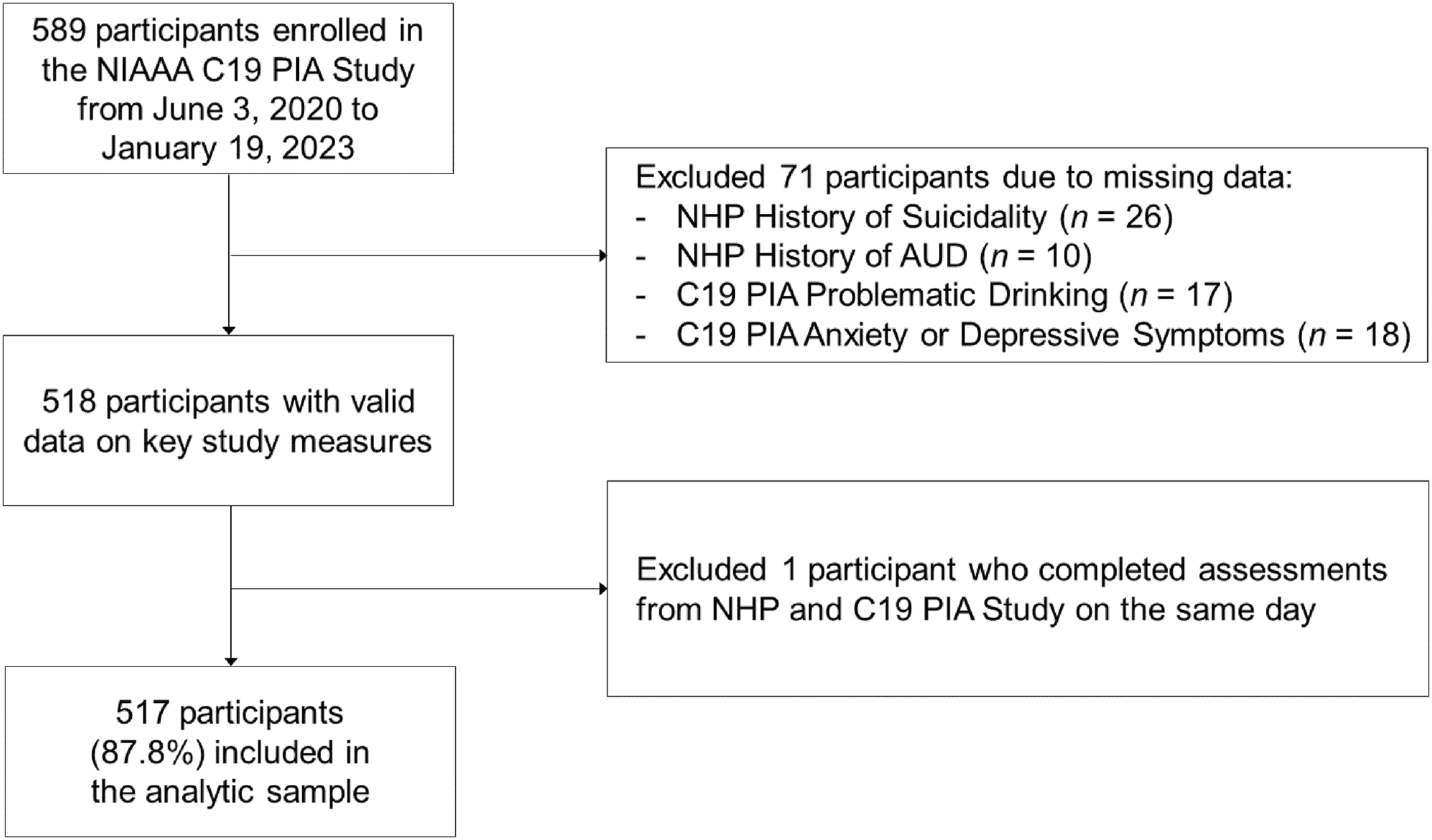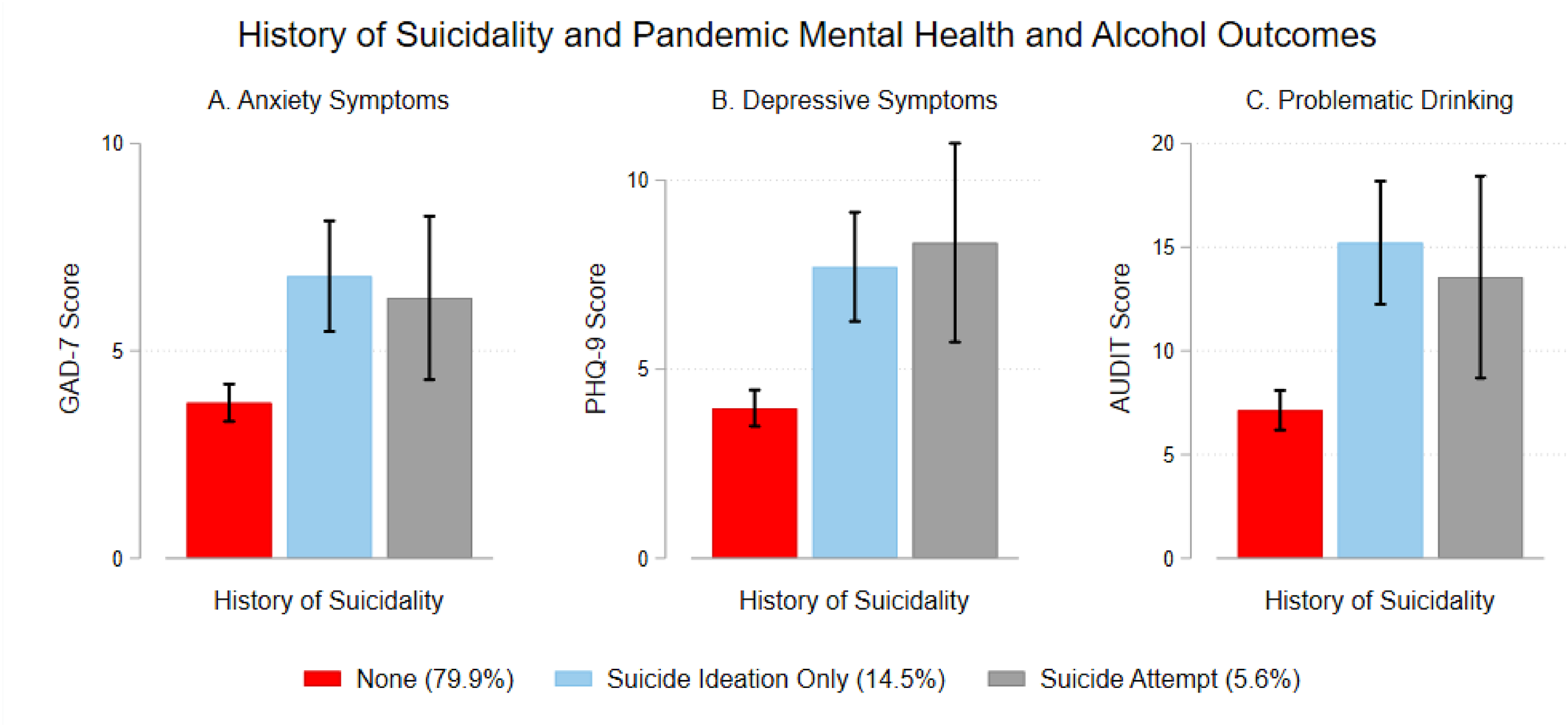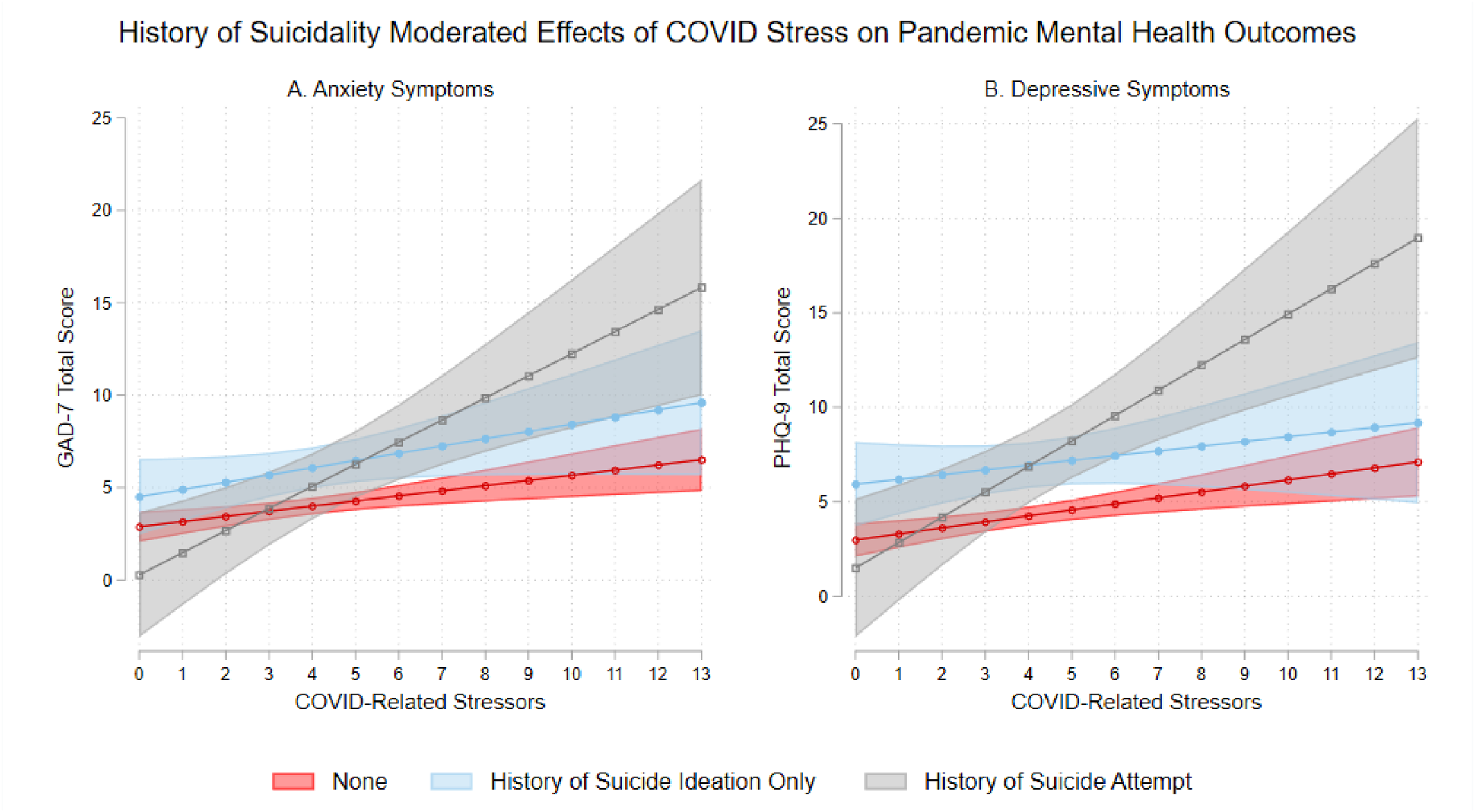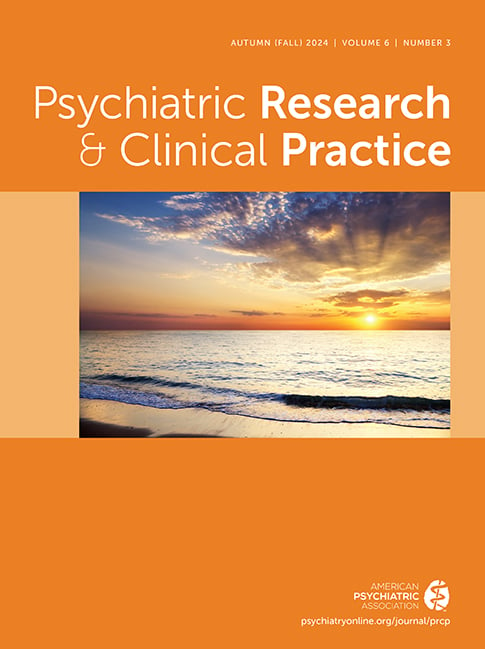History of Suicidality and Pandemic Outcomes: Longitudinal Associations with Anxiety Symptoms, Depressive Symptoms, and Problematic Drinking
Abstract
Objective
Methods
Results
Conclusions
Highlights
METHOD
Participants

Measures
History of Suicidality (NHP)
History of AUD (NHP)
COVID‐Related Stressors (C19 PIA)
Anxiety Symptoms (C19 PIA)
Depressive Symptoms (C19 PIA)
Problematic Drinking (C19 PIA)
Design‐Related Covariates
Statistical Analyses
RESULTS
| Overall sample (N = 517) | None (n = 413) | Suicide ideation only (n = 75) | Suicide attempt (n = 29) | χ2 | p | |||||
|---|---|---|---|---|---|---|---|---|---|---|
| n | % | n | % | n | % | n | % | |||
| Sex | ||||||||||
| Female | 242 | 46.8 | 195 | 47.2 | 28 | 37.3 | 19 | 65.5 | 6.81 | 0.033 |
| Male | 275 | 53.2 | 218 | 52.8 | 47 | 62.7 | 10 | 34.5 | ||
| Race | ||||||||||
| White | 263 | 50.9 | 202 | 48.9 | 49 | 65.3 | 12 | 41.4 | 10.52 | 0.033b |
| Black/African American | 174 | 33.7 | 147 | 35.6 | 14 | 18.7 | 13 | 44.8 | ||
| Other | 80 | 15.5 | 64 | 15.5 | 12 | 16.0 | 4 | 13.8 | ||
| Ethnicity | ||||||||||
| Not Hispanic | 454 | 87.8 | 363 | 87.9 | 66 | 88.0 | 25 | 86.2 | 2.33 | 0.676 |
| Hispanic | 43 | 8.3 | 32 | 7.8 | 8 | 10.7 | 3 | 10.3 | ||
| Unknown | 20 | 3.9 | 18 | 4.4 | 1 | 1.3 | 1 | 3.5 | ||
| Marital status | ||||||||||
| Single | 331 | 64.0 | 265 | 64.2 | 47 | 62.7 | 19 | 65.5 | 2.17 | 0.705 |
| Married | 106 | 20.5 | 88 | 21.3 | 14 | 18.7 | 4 | 13.8 | ||
| Other | 80 | 15.5 | 60 | 14.5 | 14 | 18.7 | 6 | 20.7 | ||
| History of AUD | ||||||||||
| No | 310 | 60.0 | 283 | 68.5 | 22 | 29.3 | 5 | 17.2 | 63.96 | <0.001 |
| Yes | 207 | 40.0 | 130 | 31.5 | 53 | 70.7 | 24 | 82.8 | ||
| M | SD | M | SD | M | SD | M | SD | F | p | |
|---|---|---|---|---|---|---|---|---|---|---|
| Age | 44.59 | 14.13 | 44.43 | 14.33 | 43.91 | 13.30 | 48.69 | 13.22 | 1.34 | 0.263 |
| COVID stressors | 3.82 | 2.69 | 3.73 | 2.71 | 4.13 | 2.58 | 4.38 | 2.69 | 1.37 | 0.254 |
| Anxiety symptoms | 4.33 | 5.02 | 3.75 | 4.66 | 6.80 | 5.87 | 6.28 | 5.40 | 14.77 | <0.001c |
| Depressive symptoms | 4.76 | 5.55 | 3.97 | 4.97 | 7.71 | 6.35 | 8.34 | 7.20 | 22.58 | <0.001c |
| Problematic drinking | 8.67 | 11.04 | 7.13 | 9.89 | 15.21 | 13.08 | 13.55 | 13.34 | 21.63 | <0.001c |

| Anxiety symptoms | Depressive symptoms | Problematic drinking | |||||||
|---|---|---|---|---|---|---|---|---|---|
| b | SE | p | b | SE | p | b | SE | p | |
| Intercept | 4.02 | 0.92 | <0.001 | 4.79 | 1.00 | <0.001 | 1.02 | 1.61 | 0.526 |
| COVID‐related stressors | 0.28 | 0.09 | 0.002 | 0.32 | 0.10 | 0.001 | 0.44 | 0.16 | 0.005 |
| History of suicidality | |||||||||
| Ideation versus none | 1.62 | 1.13 | 0.151 | 2.96 | 1.22 | 0.016 | 0.36 | 1.97 | 0.854 |
| Attempt versus none | −2.60 | 1.78 | 0.145 | −1.48 | 1.94 | 0.445 | 3.78 | 3.11 | 0.225 |
| Interactions | |||||||||
| COVID‐related stressors × ideation | 0.11 | 0.23 | 0.622 | −0.07 | 0.25 | 0.786 | 0.61 | 0.40 | 0.130 |
| COVID‐related stressors × attempt | 0.92 | 0.34 | 0.008 | 1.03 | 0.37 | 0.006 | −0.72 | 0.60 | 0.233 |
| Enrollment phase | |||||||||
| 2 versus 1 | 0.47 | 0.73 | 0.521 | −0.21 | 0.80 | 0.793 | 0.59 | 1.28 | 0.647 |
| 3 versus 1 | 0.34 | 0.73 | 0.647 | −0.27 | 0.79 | 0.737 | 3.66 | 1.28 | 0.004 |
| 4 versus 1 | 0.81 | 0.75 | 0.280 | 0.32 | 0.82 | 0.697 | 5.37 | 1.31 | <0.001 |
| 5 versus 1 | −0.35 | 0.71 | 0.623 | −0.26 | 0.77 | 0.737 | 3.36 | 1.24 | 0.007 |
| Cohort | |||||||||
| 1 year versus <1 year | 1.65 | 0.72 | 0.023 | 2.26 | 0.79 | 0.004 | −1.50 | 1.26 | 0.235 |
| 2–3 years versus <1 year | 0.60 | 0.71 | 0.403 | 1.48 | 0.77 | 0.056 | −2.93 | 1.24 | 0.019 |
| 4+ years versus <1 year | −1.02 | 0.72 | 0.160 | −0.34 | 0.79 | 0.670 | −4.19 | 1.26 | 0.001 |
| Age | −0.04 | 0.02 | 0.028 | −0.05 | 0.02 | 0.004 | −0.01 | 0.03 | 0.846 |
| Sex | |||||||||
| Male versus female | −0.22 | 0.43 | 0.609 | −0.53 | 0.46 | 0.252 | 0.17 | 0.75 | 0.824 |
| Race | |||||||||
| Black/African versus White | −0.57 | 0.48 | 0.230 | −0.70 | 0.52 | 0.175 | −1.59 | 0.83 | 0.057 |
| Other versus White | −0.31 | 0.65 | 0.633 | −0.92 | 0.70 | 0.193 | −2.26 | 1.13 | 0.047 |
| Hispanic | |||||||||
| Hispanic versus non‐Hispanic | −0.53 | 0.80 | 0.507 | −0.47 | 0.86 | 0.585 | 2.10 | 1.39 | 0.130 |
| Unknown versus non‐Hispanic | −0.67 | 1.10 | 0.546 | −0.70 | 1.20 | 0.560 | 3.24 | 1.93 | 0.093 |
| Marital status | |||||||||
| Married versus single | −0.75 | 0.56 | 0.177 | −0.68 | 0.60 | 0.261 | 0.60 | 0.97 | 0.534 |
| Other versus single | −0.80 | 0.63 | 0.204 | 0.87 | 0.69 | 0.207 | 2.71 | 1.10 | 0.014 |
| History of AUD | 1.70 | 0.48 | <0.001 | 1.79 | 0.52 | 0.001 | 12.34 | 0.84 | <0.001 |

DISCUSSION
Supplementary Material
- Download
- 22.90 KB
REFERENCES
Information & Authors
Information
Published In
History
Authors
Author Contributions
Author Contributions
Author Contributions
Author Contributions
Funding Information
Metrics & Citations
Metrics
Citations
Export Citations
If you have the appropriate software installed, you can download article citation data to the citation manager of your choice. Simply select your manager software from the list below and click Download.
For more information or tips please see 'Downloading to a citation manager' in the Help menu.
View Options
View options
PDF/EPUB
View PDF/EPUBLogin options
Already a subscriber? Access your subscription through your login credentials or your institution for full access to this article.
Personal login Institutional Login Open Athens loginNot a subscriber?
PsychiatryOnline subscription options offer access to the DSM-5-TR® library, books, journals, CME, and patient resources. This all-in-one virtual library provides psychiatrists and mental health professionals with key resources for diagnosis, treatment, research, and professional development.
Need more help? PsychiatryOnline Customer Service may be reached by emailing [email protected] or by calling 800-368-5777 (in the U.S.) or 703-907-7322 (outside the U.S.).
